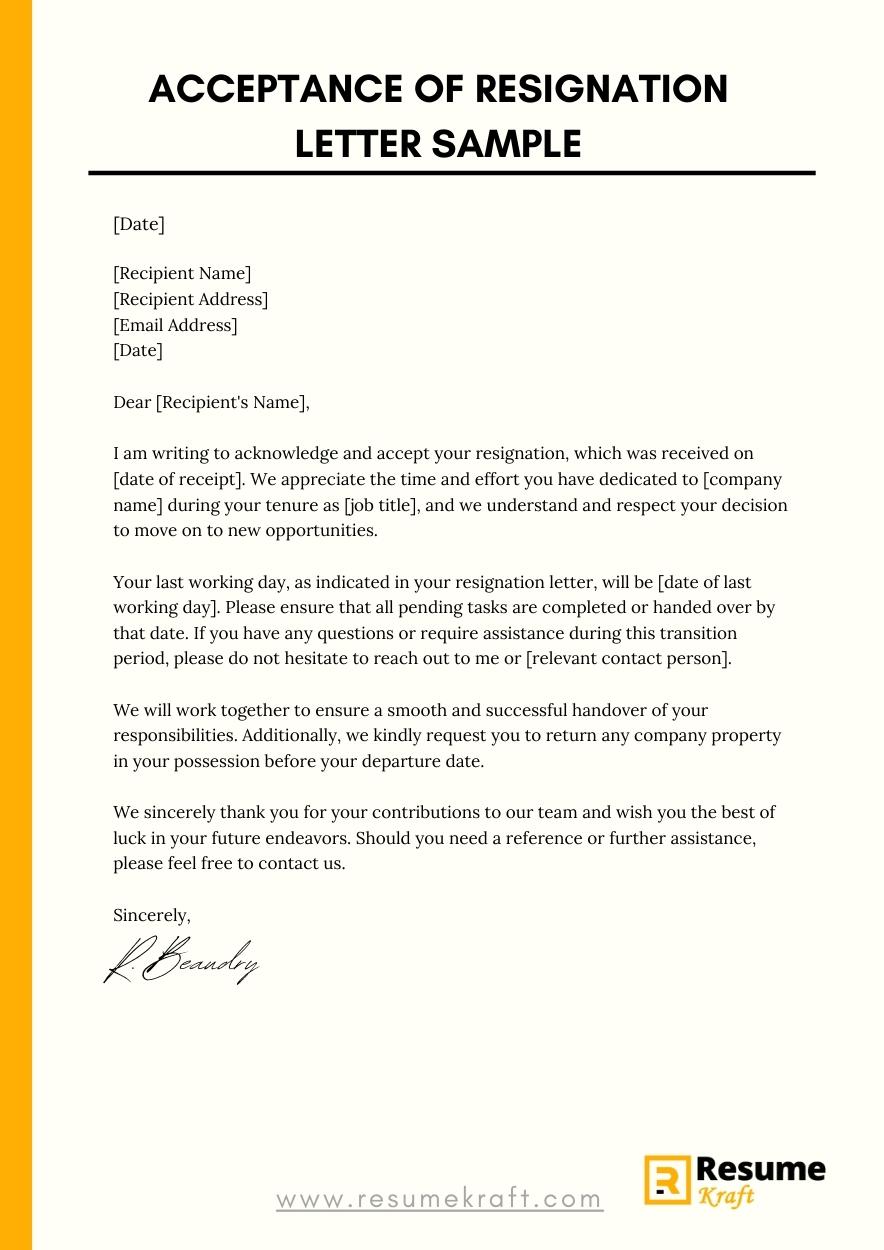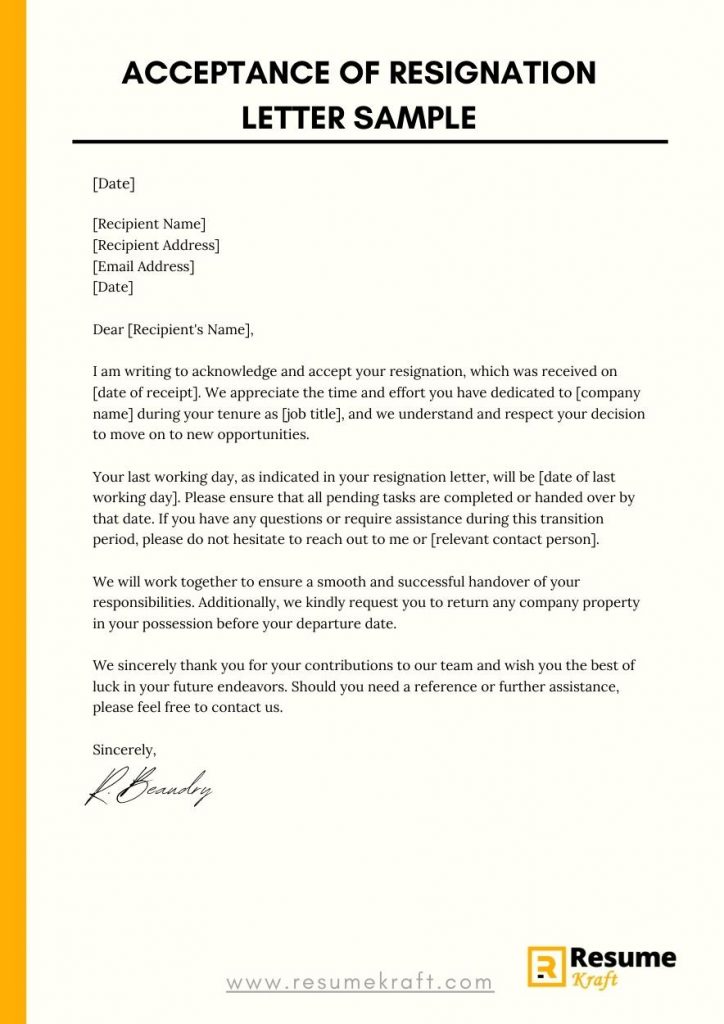
Resignation letters are a common part of the professional world. When an employee decides to leave their position, it is crucial for the employer or manager to respond with an acceptance letter. In this article, we will discuss the key elements to include in an acceptance of resignation letter and provide sample letters for different scenarios. Whether you are accepting a resignation in person, by email, or through a printed letter, this guide will help you navigate this process with grace and professionalism.
- What To Include in an Acceptance of Resignation Letter
- What Not to Include in Your Acceptance of Resignation Letter
- How To Format an Acceptance of Resignation Letter
- Acceptance of Resignation Letter Sample
- Key Takeaways
- Frequently Asked Questions (FAQs)
- Q1. Can I reject a resignation letter?
- Q2. Do I need to mention the reason for accepting the resignation?
- Q3. Should I include potential replacement information in the acceptance letter?
- Q4. How can I maintain a positive relationship with the resigning employee?
- Q5. Is it important to keep the acceptance letter formal?
- Conclusion
What To Include in an Acceptance of Resignation Letter
When writing an acceptance of resignation letter, it’s important to include the following key elements:
- Express appreciation: Start the letter by expressing gratitude for the employee’s service and contribution to the company. Acknowledge their decision to resign and show respect for their choice.
- Accept the resignation: Clearly state that you accept the employee’s resignation. This confirms that you have received and acknowledged their intention to leave the company.
- Confirm the last working day: Mention the accepted last working day as communicated by the employee in their resignation letter. This avoids any confusion or misunderstandings regarding the employee’s departure date.
- Offer assistance: Extend support and assistance during the transition period. Let the employee know that you are available to answer any questions or provide guidance if needed.
- Inform about exit process: Provide information regarding the exit process, such as returning company property, completing necessary paperwork, or scheduling an exit interview if applicable.
- Wish them well: End the letter on a positive note by wishing the employee success in their future endeavors. This shows goodwill and maintains a professional relationship.
What Not to Include in Your Acceptance of Resignation Letter
While writing an acceptance of resignation letter, it is important to avoid the following:
- Negative comments or criticisms: Keep the letter focused on expressing gratitude and acceptance. Avoid negative comments about the employee’s performance or reasons for leaving.
- Personal opinions or emotions: Maintain a professional tone and refrain from expressing personal opinions or emotions in the acceptance letter.
- Promises you cannot keep: Be cautious when making promises or offering assistance. Only commit to what you can reasonably provide or fulfill.
- Mention of potential replacement: Avoid discussing potential replacements in the acceptance letter. This information can be communicated separately and may not be relevant to the employee leaving.
- Confidential or sensitive information: Do not disclose any confidential or sensitive information in the acceptance letter. Respect the employee’s privacy and keep the focus on the resignation process.
How To Format an Acceptance of Resignation Letter
A professional and well-formatted acceptance of resignation letter should include the following:
- Date: Begin the letter with the date of writing, to form a relational reference for future correspondence.
- Employee details: Include the employee’s full name, job title, and department to ensure clarity and accuracy in the letter.
- Employer details: Provide the employer’s name, company name, and address. This information helps in identifying the sender and establishes the official nature of the letter.
- Salutation: Start the letter with a formal salutation, such as “Dear [Employee’s Name].”
- Body: Write a clear and concise body that covers the essential elements mentioned earlier. Use appropriate paragraphs to maintain organization and readability.
- Closing and signature: End the letter with a closing phrase, such as “Sincerely” or “Best regards.” Leave space for the sender’s signature and printed name.
Acceptance of Resignation Letter Sample
Here are two sample acceptance letters: one for a printed letter and another for an email response.

Printed Resignation Letter Sample
Dear [Employee’s Name],
I am writing to acknowledge and accept your resignation, which was received on [date of receipt]. We appreciate the time and effort you have dedicated to [company name] during your tenure as [job title], and we understand and respect your decision to move on to new opportunities.
Your last working day, as indicated in your resignation letter, will be [date of last working day]. Please ensure that all pending tasks are completed or handed over by that date. If you have any questions or require assistance during this transition period, please do not hesitate to reach out to me or [relevant contact person].
We will work together to ensure a smooth and successful handover of your responsibilities. Additionally, we kindly request you to return any company property in your possession before your departure date.
We sincerely thank you for your contributions to our team and wish you the best of luck in your future endeavors. Should you need a reference or further assistance, please feel free to contact us.
Sincerely,
[Your Name]
[Your Position]
[Company Name]
Email Resignation Letter Example
Subject Line: Acceptance of Resignation
Dear [Employee’s Name],
I hope this email finds you well. I am writing to acknowledge and formally accept your resignation, which you submitted on [date of receipt]. We appreciate the dedication and hard work you have consistently demonstrated during your time at [company name].
I accept your resignation and understand that your last working day will be [date of last working day]. Please ensure that all outstanding tasks are properly documented and handed over to the appropriate team members before your departure. If you need any assistance or have any questions during this transition period, please do not hesitate to reach out to me.
As per our company policy, please return all company property, including your identity card and any equipment or materials issued to you, prior to your last working day. [Provide instructions for returning company property, if applicable].
We would like to express our gratitude for your contributions to the team and wish you the best of luck in your future endeavors. Should you require a reference or any assistance, please do not hesitate to contact us.
Thank you once again, and we look forward to a smooth handover process.
Best regards,
[Your Name]
[Your Position]
[Company Name]
Key Takeaways
Responding to a resignation letter with a well-written acceptance letter is essential for maintaining a professional relationship with the departing employee. Remember the following key points when crafting your response:
- Express gratitude for the employee’s service and contribution.
- Clearly accept the resignation and confirm the last working day.
- Offer support and assistance during the transition period.
- Provide information on the exit process.
- Wish the employee success in their future endeavors.
Frequently Asked Questions (FAQs)
Frequently Asked Questions (FAQs)
Q1. Can I reject a resignation letter?
A1. While technically employers have the right to reject a resignation, it is generally advisable to accept it gracefully and professionally. Rejecting a resignation may strain the relationship with the employee and can create a negative atmosphere in the workplace.
Q2. Do I need to mention the reason for accepting the resignation?
A2. No, it is not necessary to mention the reason for accepting the resignation in the acceptance letter. The focus of the acceptance letter should be on acknowledging the employee’s decision and providing necessary information for the transition. Mentioning the reason for acceptance might not be relevant and can potentially create confusion or unnecessary discussion.
Q3. Should I include potential replacement information in the acceptance letter?
A3. It is not necessary to mention potential replacements in the acceptance letter. This information can be discussed separately with the appropriate parties involved in the hiring process. The acceptance letter should primarily focus on acknowledging the employee’s resignation and providing support during the transition period.
Q4. How can I maintain a positive relationship with the resigning employee?
A4. To maintain a positive relationship with the resigning employee, consider the following:
- Express gratitude: Thank the employee for their contributions and express appreciation for their service to the company.
- Offer support: Provide assistance during the transition period, such as answering questions or offering guidance if needed.
- Maintain open communication: Keep the lines of communication open, so the employee feels comfortable reaching out if they have any concerns or require further assistance.
- Offer a reference: If appropriate, offer to provide a reference for the employee in their future job search.
- Wish them well: End the acceptance letter on a positive note by wishing the employee success in their future endeavors.
Q5. Is it important to keep the acceptance letter formal?
A5. Yes, it is important to maintain a professional and formal tone in the acceptance letter to uphold the standards of the workplace. This helps to establish a clear and respectful communication between the employer and employee during the resignation process. Avoid using overly casual or colloquial language in the letter, as it may undermine the professionalism of the communication.
Conclusion
Writing a polite and professional acceptance of resignation letter is essential when an employee decides to leave a company. By including gratitude, accepting the resignation, providing assistance, and maintaining a professional tone, you can ensure a smooth and respectful transition for both the resigning employee and the organization. Use the sample acceptance letters provided above as templates to craft your own personalized response.

